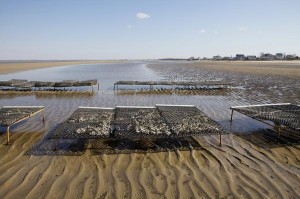Oyster Co-Op Receives Grant for Refrigerated Van to Promote Long Term Sustainability of Shellfish Farms
The Cape May Oyster Cooperative, a newly established cooperative comprised of six founding member oyster farms, has received funds from USDA’s Rural Business Enterprise to purchase a refrigerated van, which will ensure the safe delivery of product from field to packing facility and enable the integration of direct delivery to local food markets. Lisa Calvo, extension agent for the NJSGC, is the Aquaculture Program Coordinator at Rutgers University’s Haskin Shellfish Research Laboratory and has been a key resource in guiding the co-op initiative.
The collective of primarily family farmers seeks to employ stringent product quality and safety standards and to establish capacity for direct delivery of product to high end restaurants, specialty markets, CSAs, and food cooperatives serving a growing consumer demand for fresh, locally produced foods. The Co-op’s distribution business model supports market expansion, expanded product access to under served consumers, and promotes long term sustainability of shellfish farms.
In order to enhance the production potential, marketing opportunities, and long-term sustainability of their farms, a group of six oyster farms came together to identify ways to work cooperatively. The group has met monthly since January 2012 to establish a framework for a producer’s cooperative, the Cape May Oyster Cooperative. Guided by Rutgers University New Jersey Aquaculture Innovation and Food Innovation Center experts, cooperative development consultant, Adam Schwartz, and Attorney Dave Swanson, the Cape May Oyster Cooperative has been established as a 308B Cooperative in Minnesota, where there is a robust legal basis for farmer cooperatives. The Cooperative continues to work closely with the experts to ensure proper execution of the cooperative endeavor and associated marketing strategies.
New Jersey’s oyster farms are concentrated on extensive intertidal sand flats of the lower Delaware Bay known as the Cape Shore. The moderately high salinity and good food quality characteristic of this area supports rapid oyster growth and yields exceptional quality oysters. Here, hatchery-reared disease resistant oysters are grown in rack and bag systems. The farms are accessed from the shore at low tide and the oysters are tended for a 1-3 year production cycle. At the start of 2013, seven oyster farms had 17.3 million oysters in production in Delaware Bay (Calvo, 2013).
Member farms are primarily located adjacent to one another along a three-mile stretch of shoreline on the Cape Shore flats and in tidal areas located within about a 10-mile radius of the near shore zone. The geographic centralization of the farms creates an ideal opportunity for farmers to work cooperatively as they produce similar high quality oysters in similar growing conditions. The cooperative will strengthen its community of member farmers by sharing infrastructure, services, and marketing, forging a collective path forward that could not be achieved by any single individual farm.
